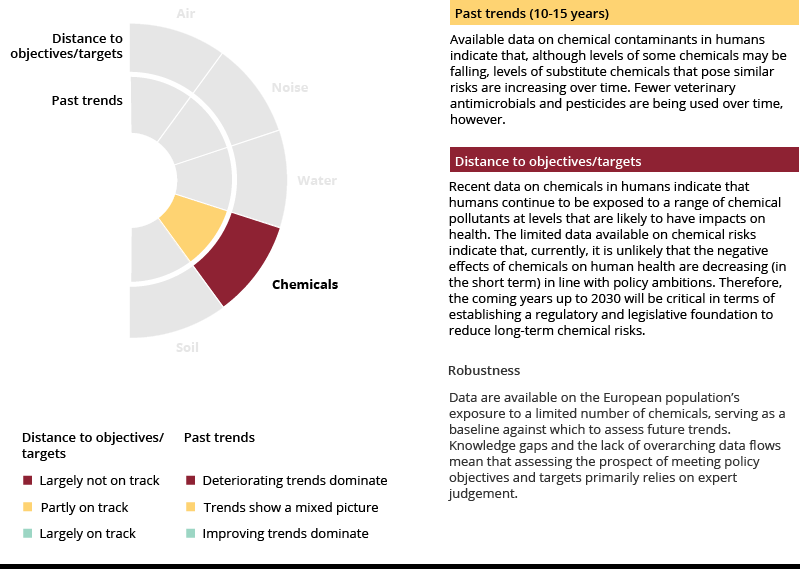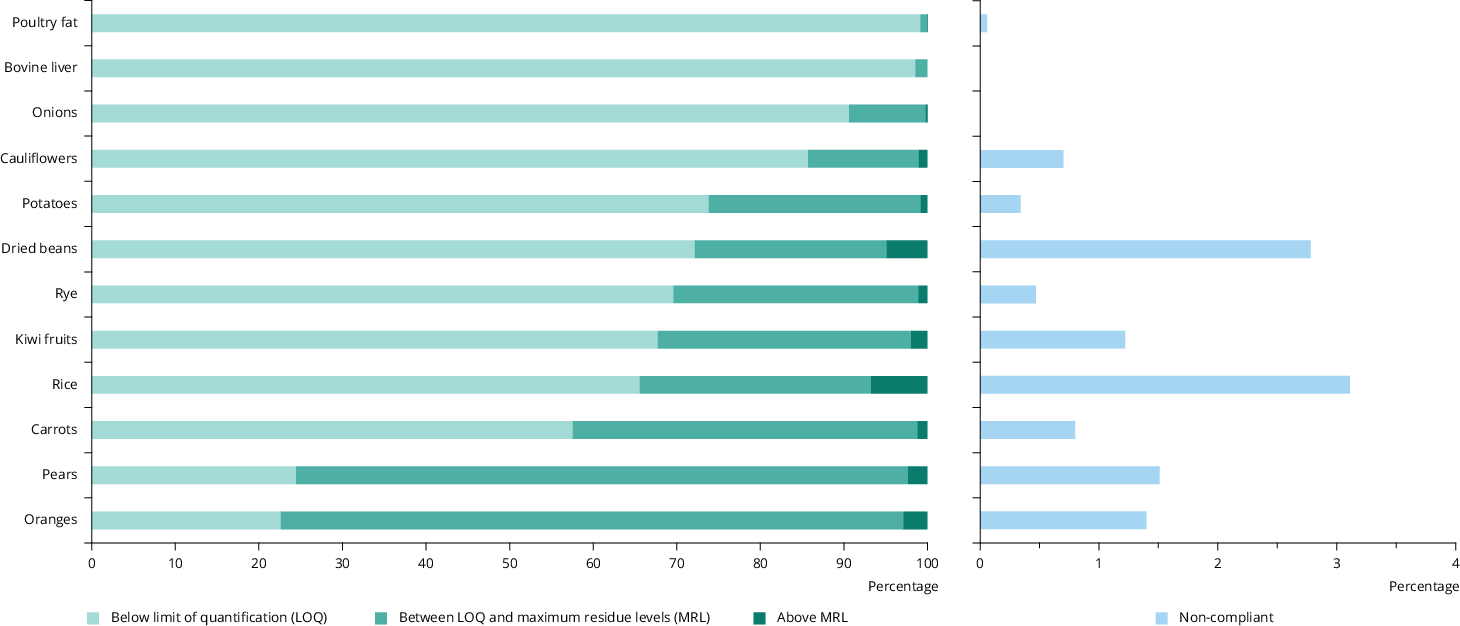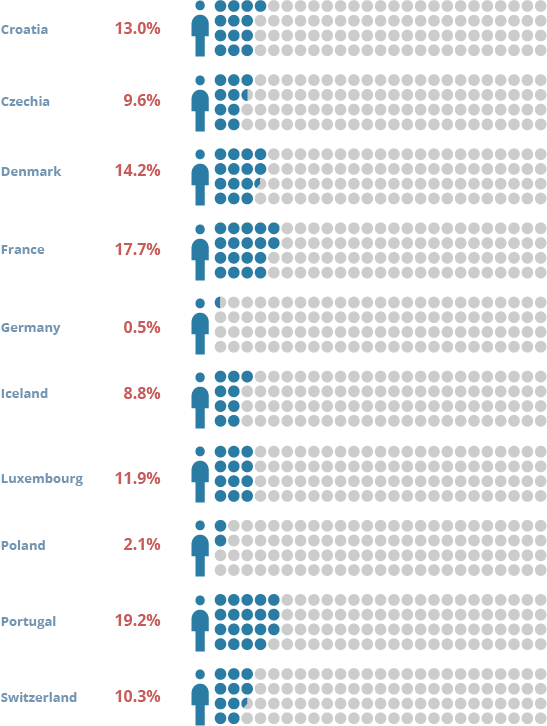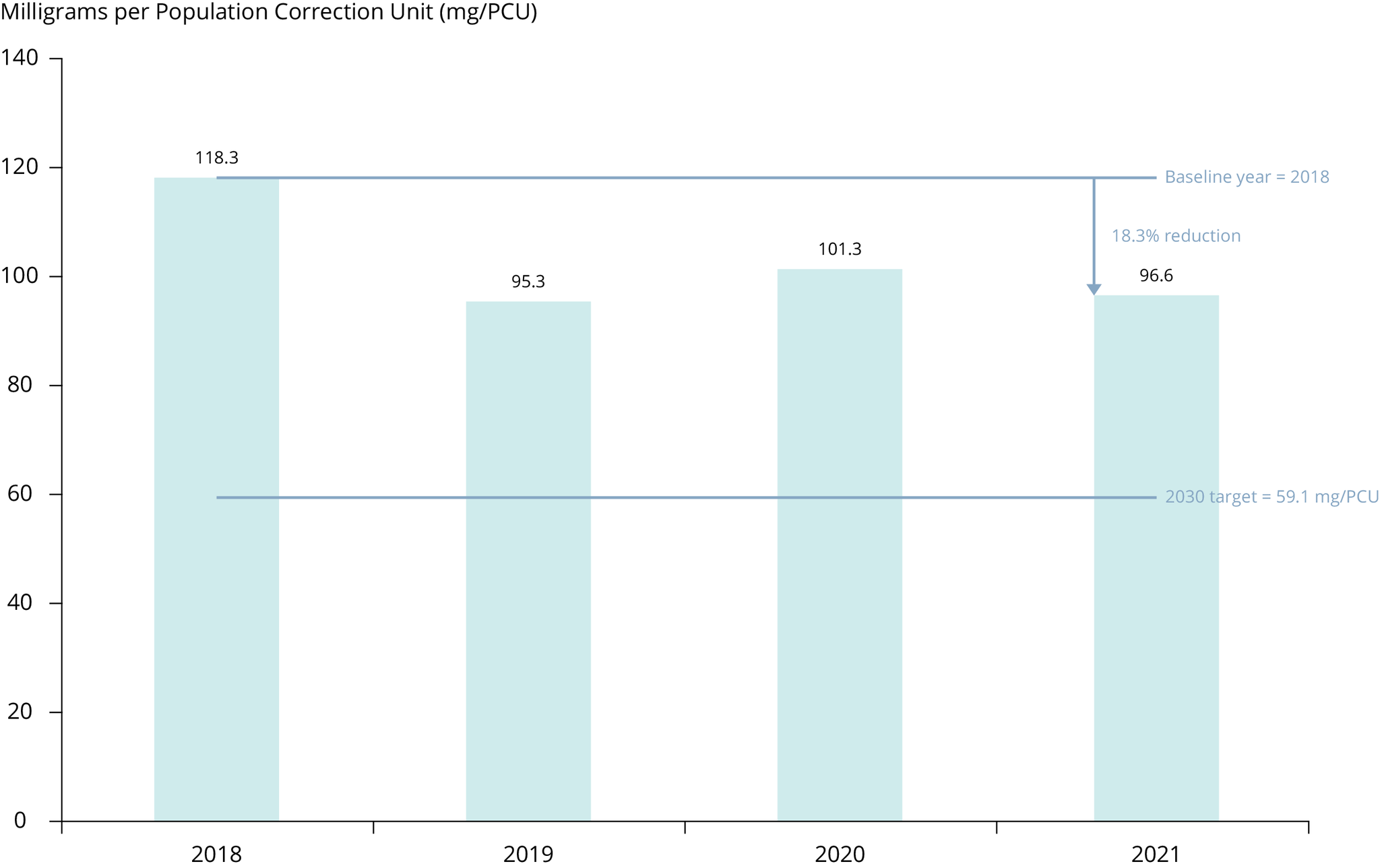Key messages
- Europe continues to produce and use large quantities of chemicals that are hazardous to health.
- Both the regulation and monitoring of chemicals have historically failed to keep up with the synthesis and use of new chemicals. This results in issues such as regrettable substitution and a lack of data on emerging chemicals in the environment and people.
- The bodies of EU citizens are contaminated by a range of harmful chemicals above safe levels.
- In 2021, sales of veterinary antimicrobials were more than 18% lower than in the baseline year of 2018. The zero pollution target is a 50% reduction by 2030; hence, although progress is positive, significant additional effort will be needed to maintain this downward trend and meet the target.

Guidance for interpreting the summary
The infographic above summarises the overall findings on chemical pollution. Two dimensions are considered:
- whether the recent trend in pollution is positive, negative or uncertain
- the current 'distance to target', based on an assessment of the current trends or status and whether or not the EU is on track to achieve the defined zero pollution targets for 2030 and/or other relevant policy targets.
The assessment is based on a combination of (1) available indicators and data, and (2) expert judgement.
Introduction
Europe continues to manufacture and use a large variety of chemicals that are hazardous to human health, as explained in the zero pollution production and consumption section. People are exposed to complex mixtures of chemicals in their daily lives by consuming contaminated food and drink, breathing in polluted air and dust, and using consumer goods. As a result, our bodies contain multiple manufactured chemicals. This section examines human exposure to chemicals via diet and occupational exposure; it also assesses the risks posed by chemicals in consumer products. The health risks associated with chemicals in air pollution, water pollution and soil pollution are addressed in other sections of this report.
Recently, the EU Horizon European Human Biomonitoring Initiative (HBM4EU) yielded data on human exposure to chemicals from harmonised human biomonitoring studies across Europe. The data provide a picture of how chemicals burden the body and impact health. Some of the emerging data from this project are presented here to illustrate the value of human biomonitoring in assessing risks from chemicals to humans. The recently initiated Partnership for the Assessment of Risks from Chemicals (PARC) will further build on HBM4EU experiences and results.
Managing risks from chemicals to health
The EU benefits from a comprehensive set of chemical policies designed to protect citizens and workers, as well as the environment, from hazardous chemicals. Principal legislative mechanisms include the Registration, Evaluation, Authorisation and Restriction of Chemicals (REACH) and the Classification, Labelling and Packaging of Substances and Mixtures (CLP) Regulations, with policies addressing specific products, such as biocides , pesticides, cosmetics and pharmaceuticals, as well as food contact materials. Limits are also in place for chemical contaminants and pesticide residues in food, as well as for drinking water quality; meanwhile, monitoring requirements check compliance. Specific policies focus on endocrine disruptors, chemical mixtures (see zero pollution ‘Signal’ on chemical mixtures) and per- and polyfluoroalkyl substances (PFAS) (see zero pollution cross-cutting story on PFAS).
The European Commission’s chemicals strategy for sustainability aims to better protect citizens and the environment while boosting innovation for safe and sustainable chemicals. The strategy also promotes a move towards a more generic risk assessment approach, where chemicals are regulated in groups rather than individually. The EEA will publish an indicator framework to track progress towards these objectives in 2024, in cooperation with the European Chemicals Agency.
How chemicals impact health
Exposure to chemical pollution is linked to a wide range of health impacts — some of which are serious and irreversible. Certain chemicals cause chronic diseases, neurological disorders and damage to genetic material, and some affect fertility by disrupting the endocrine system. Pregnant women and young children are particularly vulnerable to exposure to hazardous chemicals; a foetus can be exposed in the womb to chemicals in the body of the mother that cross the placental barrier, while babies can be exposed via their mothers’ breast milk (EEA, 2020).
Dietary exposure to chemicals
Diet is a major source of exposure to hazardous chemicals in Europe (Papadopoulou et al., 2019). Crops may be contaminated by chemicals absorbed from soil or water and animals may be contaminated by consuming contaminated organisms. They may also be contaminated by pesticides applied to crops and during food production or processing, and via food contact materials.
Pesticide residues in food
Pesticide exposure is linked to a range of chronic diseases, including diabetes, cancer and neurodegenerative diseases, as well as reduced fertility and birth defects (Fucic et al., 2021). Some pesticides are endocrine-disrupting chemicals, with the potential to affect health at low doses (Leemans et al., 2019). However, recent monitoring data on pesticide residues (Figure 17) in food show that dietary exposure to those pesticides is unlikely to pose a risk to consumer health. In terms of the trend over time, between 2017 and 2020, the overall rate of exceedance of maximum residue levels rose slightly from 1.7% of samples to 2.1%.
Trends in the use and risk of chemical pesticides are declining, as detailed in the zero pollution production analysis. This is promising, but these trends are not yet reflected in a reduction in the pesticide levels being measured in foods.

Note: LOQ, limit of quantification; MRL, maximum residue level.
Source: EFSA (2022).
Click here to view the figure enlarged
Click here for different chart formats and data
Estimating risks from other chemical food contaminants
The European Food Safety Authority (EFSA) assesses the risk of human exposure to a range of chemicals via diet. These include environmental pollutants such as brominated flame retardants, dioxins and polychlorinated biphenyls (PCBs) and heavy metals such as arsenic, methylmercury, lead, nickel and cadmium. The EFSA publishes opinions on its findings. These opinions are periodically updated as needed to reflect the latest scientific knowledge. For example, the EFSA reduced the tolerable daily intake for dioxins/PCBs by a factor of seven in 2018.
Human biomonitoring is a methodology used for measuring the levels of these chemicals in our bodies and the risks they pose. Examples of biomonitoring data are presented below for two relevant chemicals, bisphenols and phthalates.
Bisphenols are synthetic chemicals used to manufacture plastics and resins. Bisphenol A (BPA) acts as an endocrine disruptor and is toxic to reproduction, with early evidence suggesting that BPF and BPS have similar effects (Haverinen et al., 2021). Bisphenols may migrate into food or drinks from food contact materials, such as epoxy resins used in food cans and polycarbonate plastics used in containers. In the EU, the use of BPA is permitted in food contact materials. In 2011, the use of BPA in polycarbonate infant bottles was banned, and this ban was extended to children’s drinking bottles in 2018.
HBM4EU detected BPA in 92% of all adult participants in a sample population from across 10 European countries, while the substitutes BPS and BPF were detected in 67% and 62% of adult participants, respectively (HBM4EU, 2022a). Figure 18 shows the shares of the populations of 10 European countries with BPS levels exceeding the established health-based human biomonitoring guidance value (Ougier et al., 2021a). HBM4EU monitoring results for BPS over the period 2014-2021 show significantly higher concentrations than data from the period 2010-2012 (HBM4EU, 2022b). These increasing levels of BPA substitutes such as BPS are concerning, given the known health risks associated with bisphenols.

Source: HBM4EU (2022b).
Another group of chemicals that humans are exposed to through diet are phthalates, which are widely used to soften plastics, including those used in food contact materials. Certain phthalates can have an impact on reproduction and development (Eales et al., 2022). HBM4EU monitored phthalates in children and teenagers from 11 European countries and found that 4% of children exceeded the human biomonitoring guidance value for di-n-butyl phthalate (DnBP), while at least 4% of the children and 1% of the teenagers exceeded the guidance value for di-isobutyl phthalate (DiBP). Phthalates act cumulatively, so 17% of European children and adolescents are at risk from combined exposure to mixtures of phthalates (HBM4EU, 2022c).
Consumer exposure to chemicals in products
People are exposed to a wide range of chemicals in consumer products, some of which are hazardous, through direct contact with products or by breathing in chemicals released to air, or dust containing chemicals. Indoor dust in homes has been found to contain a range of chemicals, including phthalates (Demirtepe et al., 2021). The shift towards a circular economy could potentially create new exposure pathways, namely when materials are recycled at the end of a product’s life.
The European Rapid Alert System for Dangerous Products (RAPEX) is the EU’s system for exchanging information on unsafe consumer products for consumer protection, established under the General Product Safety Directive. National authorities in the EU Member States can rapidly share information on measures taken in relation to dangerous products, including products that pose chemical risks. In 2021, 25% of safety alerts signalled a chemical risk, second in frequency to only injuries in terms of the type of alert. Typically, only 25% of alerts relate to products originating within the EU or European Economic Area. Examples of chemical risk alerts have included phthalates detected in plastic and lead detected in metal products (EC, 2022b).
Consumer exposure can also change as a result of occurrences such as the COVID-19 pandemic. For example, during the COVID-19 pandemic, exposure to chemicals from cleaning and disinfection products increased (Soave et al., 2021).
Occupational exposure to chemicals
In certain occupational settings, workers may be exposed to hazardous chemicals across a range of economic sectors, including agriculture, mining, construction, manufacturing and services (ILO, 2021). Current efforts to establish a circular economy may generate new risks for workers in the waste management sector, with particular concerns regarding workers who recycle waste electrical and electronic equipment. For example, exposure to flame-retardant chemicals contained in such equipment is an issue (HBM4EU, 2022d).
One historical and very significant example of occupational exposure relates to the use of asbestos. It is estimated that, in the EU in 2019, more than 70,000 premature deaths were the result of historical exposure to asbestos, as outlined in the zero pollution ‘Signal’ on asbestos.
Antimicrobial resistance — reduced sales of antimicrobials for farmed animals and aquaculture
Antimicrobial resistance (AMR) is the ability of microorganisms, such as bacteria, to become resistant to an antimicrobial to which they were previously susceptible. AMR is a consequence of natural selection and genetic mutation. This natural selection process is exacerbated by human factors such as the inappropriate use of antimicrobials in human and veterinary medicine, and poor hygiene conditions and practices in healthcare settings and the food chain. This facilitates the transmission of resistant microorganisms and, over time, makes antimicrobials less effective and ultimately useless in treating infections. The topic of AMR is considered in more detail in the zero pollution 'Signal' on antimicrobial resistance.
The zero pollution action plan includes a specific target to reduce sales of antimicrobials for farmed animals and aquaculture by 50% by 2030 (compared with 2018 levels). This aims to ensure that antimicrobials are used only when necessary and to reduce the risk of AMR development and the transfer of antimicrobial-resistant microorganisms through the food chain.
Figure 19 shows the progress made in reducing sales of antimicrobials in recent years. Since 2018, sales have reduced by approximately 18.3%. Although it is still too early to properly assess the trend, progressing at this downwards rate would result in the target 50% reduction being achieved by 2030. Information on antimicrobial sales on a country-by-country basis can be found in the European Medicines Agency European Database of Sales of Veterinary Antimicrobial Agents (ESVAC database).

Note: PCU, population correction unit. In order to normalise the sales data for the animal population that can be subjected to treatment with antimicrobial agents, a population correction unit (PCU) is used as a proxy for the size of the animal population, taking into account the population and relative weight of animals.
Source: Data provided to the EEA by the European Medicines Agency, September 2022.
Click here for different chart formats and data
Indicator analysis — chemicals and health
No specific, regularly updated indicators relate to chemicals and health and therefore none were included in this assessment. This means that a regularly updated knowledge base needs to be developed on this topic. The monitoring framework being developed under the European Commission’s chemicals strategy for sustainability will eventually provide indicators that will also support reporting under the zero pollution action plan.
Indicators related to chemicals are presented elsewhere in this assessment — including indicators on the production and consumption of hazardous chemicals and on the risk and use of chemical pesticides.
References
Demirtepe, H., et al., 2021, ‘Targeted and suspect screening of plasticizers in house dust to assess cumulative human exposure risk’, Science of the Total Environment781, 146667, (https://doi.org/10.1016/j.scitotenv.2021.146667).
Eales, J., et al., 2022, ‘Human health impacts of exposure to phthalate plasticizers: an overview of reviews’, Environment international 158, 106903 (https://doi.org/10.1016/j.envint.2021.106903).
EC, 2022b, Safety Gate 2021 results: modelling cooperation for health and safety of consumers in the European Union, European Commission, Brussels, (https://ec.europa.eu/safety/consumers/consumers_safety_gate/statisticsAndAnualReports/2021/RAPEX_2021_report_EN.pdf) accessed 6 October 2022.
EEA, 2020, Healthy environment, healthy lives: how the environment influences health and well-being in Europe, EEA Report No 21/2019, EEA (https://www.eea.europa.eu/publications/healthy-environment-healthy-lives) accessed 6 October 2022.
EFSA, 2022, ‘The 2020 European Union report on pesticide residues in food’, EFSA Journal20(3), 7215, European Food Safety Authority, (https://www.efsa.europa.eu/en/efsajournal/pub/7215) accessed 6 October 2022.
Fucic, A., et al., 2021, ‘Reproductive health risks associated with occupational and environmental exposure to pesticides’, International Journal of Environmental Research and Public Health18(12), 6576 (https://doi.org/10.3390/ijerph18126576).
Haverinen, E., et al., 2021, ‘Metabolic syndrome and endocrine disrupting chemicals: an overview of exposure and health effects’, International Journal of Environmental Research and Public Health18(24), 13047 (https://doi.org/10.3390/ijerph182413047).
HBM4EU, 2022a, Bisphenols, HBM4EU Policy Brief, European Human Biomonitoring Initiative (https://www.hbm4eu.eu/wp-content/uploads/2022/05/Policy-Brief-Bisphenols.pdf) accessed 6 October 2022.
HBM4EU, 2022b, Policy implications of the indicators, Additional Deliverable Report AD5.6, WP5 — translation of results into policy, European Human Biomonitoring Initiative (https://www.hbm4eu.eu/work-packages/additional-deliverable-5-6-policy-implications-of-the-indicators/) accessed 6 October 2022.
HBM4EU, 2022c, Phthalates, HBM4EU Policy Brief, European Human Biomonitoring Initiative (https://www.hbm4eu.eu/wp-content/uploads/2022/07/HBM4EU_Policy-Brief-Phthalates-1.pdf) accessed 6 October 2022.
HBM4EU, 2022d, Chemicals in a circular economy — using human biomonitoring to understand potential new exposures, European Human Biomonitoring Initiative (https://www.hbm4eu.eu/wp-content/uploads/2022/07/ChemicalsCircularEconomy.pdf) accessed 6 October 2022.
ILO, 2021, Exposure to hazardous chemicals at work and resulting health impacts: a global review, International Labour Organization, Geneva (https://www.ilo.org/wcmsp5/groups/public/---ed_dialogue/---lab_admin/documents/publication/wcms_811455.pdf) accessed 6 October 2022.
Leemans, M., et al., 2019, ‘Pesticides with potential thyroid hormone-disrupting effects: a review of recent data’, Frontiers in Endocrinology10 (https://doi.org/10.3389/fendo.2019.00743).
Ougier, E., et al., 2021a, ‘Human biomonitoring initiative (HBM4EU): Human biomonitoring guidance values (HBM-GVs) derived for bisphenol A’, Environment International154, 106563 (https://doi.org/10.1016/j.envint.2021.106563).
Papadopoulou, E., et al., 2019, ‘Diet as a source of exposure to environmental contaminants for pregnant women and children from six European countries’, Environmental Health Perspectives 127(10) (https://doi.org/10.1289/EHP5324).
Soave, P. M., et al., 2021, ‘Household disinfectant exposure during the COVID-19 pandemic: a retrospective study of the data from an Italian poison control centre’, European Review for Medical and Pharmacological Sciences25, pp. 1738-1742 (https://www.europeanreview.org/wp/wp-content/uploads/1738-1742.pdf) accessed 6 October 2022.
Cover image source: © Evangelija Ivanoska, Well with Nature /EEA




Document Actions
Share with others